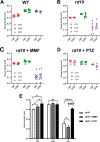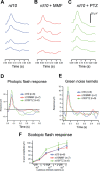Comparison of Neuroprotective Effects of Monomethylfumarate to the Sigma 1 Receptor Ligand (+)-Pentazocine in a Murine Model of Retinitis Pigmentosa
- PMID: 32150247
- PMCID: PMC7401726
- DOI: 10.1167/iovs.61.3.5
Comparison of Neuroprotective Effects of Monomethylfumarate to the Sigma 1 Receptor Ligand (+)-Pentazocine in a Murine Model of Retinitis Pigmentosa
Abstract
Purpose: Activating the cell survival modulator sigma 1 receptor (Sig1R) delays cone photoreceptor cell loss in Pde6βrd10/J (rd10) mice, a model of retinitis pigmentosa. Beneficial effects are abrogated in rd10 mice lacking NRF2, implicating NRF2 as essential to Sig1R-mediated cone neuroprotection. Here we asked whether activation of NRF2 alone is sufficient to rescue cones in rd10 mice.
Methods: Expression of antioxidant genes was evaluated in 661W cells and in mouse retinas after treatment with monomethylfumarate (MMF), a potent NRF2 activator. Rd10 mice were administered MMF (50 mg/kg) or the Sig1R ligand (+)-pentazocine (PTZ; 0.5 mg/kg) intraperitoneally (every other day, P14-42). Mice were evaluated for visual acuity (optokinetic tracking response), retinal function (electroretinography) and architecture (SD-OCT); histologic retinal sections were evaluated morphometrically.
Results: MMF treatment increased Nrf2, Nqo1, Cat, Sod1, and Hmox1 expression in vitro and in vivo. Visual acuity of (+)-PTZ-treated rd10 mice was similar to wild-type mice; however, MMF treatment did not alter acuity compared with nontreated rd10 mice. Cone electroretinography b-wave amplitudes were greater in PTZ-treated than nontreated or MMF-treated rd10 mice. SD-OCT assessment of retinal thickness was greater in (+)-PTZ-treated mice versus nontreated or MMF-treated rd10 mice. Morphometric assessment of the outer nuclear layer revealed approximately 18 cells/100 µm retinal length in (+)-PTZ-treated rd10 mice, but only approximately 10 to 12 cells/100 µm in MMF-treated and nontreated rd10 retinas.
Conclusions: Activation of NRF2 using MMF, at least at our dosing regimen, is insufficient to attenuate catastrophic photoreceptor damage characteristic of rd10 mice. The data prompt investigation of additional mechanisms involved in Sig1R-mediated retinal neuroprotection.
Conflict of interest statement
Disclosure:
Figures





Similar articles
-
Optimal timing for activation of sigma 1 receptor in the Pde6brd10/J (rd10) mouse model of retinitis pigmentosa.Exp Eye Res. 2021 Jan;202:108397. doi: 10.1016/j.exer.2020.108397. Epub 2020 Dec 9. Exp Eye Res. 2021. PMID: 33310057 Free PMC article.
-
Activation of Sigma 1 Receptor Extends Survival of Cones and Improves Visual Acuity in a Murine Model of Retinitis Pigmentosa.Invest Ophthalmol Vis Sci. 2019 Oct 1;60(13):4397-4407. doi: 10.1167/iovs.19-27709. Invest Ophthalmol Vis Sci. 2019. PMID: 31639826 Free PMC article.
-
Comparison of Sigma 1 Receptor Ligands SA4503 and PRE084 to (+)-Pentazocine in the rd10 Mouse Model of RP.Invest Ophthalmol Vis Sci. 2020 Nov 2;61(13):3. doi: 10.1167/iovs.61.13.3. Invest Ophthalmol Vis Sci. 2020. PMID: 33137196 Free PMC article.
-
Optical Coherence Tomography of Animal Models of Retinitis Pigmentosa: From Animal Studies to Clinical Applications.Biomed Res Int. 2019 Oct 30;2019:8276140. doi: 10.1155/2019/8276140. eCollection 2019. Biomed Res Int. 2019. PMID: 31781647 Free PMC article. Review.
-
Sigma 1 receptor: A novel therapeutic target in retinal disease.Prog Retin Eye Res. 2018 Nov;67:130-149. doi: 10.1016/j.preteyeres.2018.07.003. Epub 2018 Aug 1. Prog Retin Eye Res. 2018. PMID: 30075336 Free PMC article. Review.
Cited by
-
Sigma-1 Receptor in Retina: Neuroprotective Effects and Potential Mechanisms.Int J Mol Sci. 2022 Jul 8;23(14):7572. doi: 10.3390/ijms23147572. Int J Mol Sci. 2022. PMID: 35886921 Free PMC article. Review.
-
Monomethyl fumarate prevents alloimmune rejection in mouse heart transplantation by inducing tolerogenic dendritic cells.Acta Biochim Biophys Sin (Shanghai). 2023 May 16;55(5):866-877. doi: 10.3724/abbs.2023088. Acta Biochim Biophys Sin (Shanghai). 2023. PMID: 37184280 Free PMC article.
-
Activation of Sigma 1 Receptor Preserves Visual Function After Optic Nerve Injury.Invest Ophthalmol Vis Sci. 2025 Jul 1;66(9):13. doi: 10.1167/iovs.66.9.13. Invest Ophthalmol Vis Sci. 2025. PMID: 40622215 Free PMC article.
-
Sigma 1 receptor activation improves retinal structure and function in the RhoP23H/+ mouse model of autosomal dominant retinitis pigmentosa.Exp Eye Res. 2023 May;230:109462. doi: 10.1016/j.exer.2023.109462. Epub 2023 Mar 31. Exp Eye Res. 2023. PMID: 37003581 Free PMC article.
-
The Challenge of Dimethyl Fumarate Repurposing in Eye Pathologies.Cells. 2022 Dec 15;11(24):4061. doi: 10.3390/cells11244061. Cells. 2022. PMID: 36552824 Free PMC article. Review.
References
-
- Campochiaro PA, Mir TA. The mechanism of cone cell death in retinitis pigmentosa. Prog Retin Eye Res. 2018; 62: 24–37. - PubMed
Publication types
MeSH terms
Substances
Grants and funding
LinkOut - more resources
Full Text Sources
Molecular Biology Databases
Research Materials
Miscellaneous

